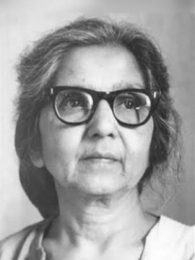
Image Credit:feminisminindia.com
Every Independence Day, we don’t fail to mention Mahatma Gandhi, Jawaharlal Nehru and many others. In our freedom fight, several people belonged to various religions, races and genders but the ambitions folded in their heart were the same. Defying all the odds of the history, one woman walked shoulder to shoulder with the men in the freedom movement of India, and that lady was Aruna Asaf Ali, one of the leading female figures of India’s freedom movement, and also an Indian educator, political activist, and publisher.
She was born as, Aruna Ganguly, on 16 July 1909 in Kalka, Punjab, British India (now in Haryana, India) into a Bengali Brahmo family. Her mother's name was Ambalika Devi and her father Upendranath Ganguly was a restaurant owner. Aruna completed her primary education in Lahore and after her graduation, she served as a teacher at the Gokhale Memorial School in Calcutta. She met Asaf Ali, a leader in the Congress party, in Allahabad. They got married in 1928, despite parental opposition on grounds of religion and age, as he was a Muslim and her senior by more than 20 years.
Raised in a liberal, upper-caste Bengali family that was part of the Brahmo Samaj and connected to Rabindranath Tagore, Aruna Ganguly was extremely well educated. Soon she became a member of Indian National Congress after marrying Asaf Ali and took part in public parades during the “Salt Satyagrah”. And she was arrested on the charge that she was a betrayer, but Aruna was so passionate and intriguing, that other women co-prisoners denied to leave the location unless she was discharged, this public uproar ensured her release.
Aruna associated with the leaders of the Indian freedom struggle and became an active member of the Congress. In 1932, she was similarly seized as a prisoner at the Tihar Jail where she fought with the insensitive handling of political prisoners by initiating a “hunger strike”. And due to this, she was moved to Ambala and was subjected to isolated imprisonment. She was politically not very active after her release due to the disruption, but at the closing of 1942, she similarly carried an underground movement.
When India was expanding its endeavour for independence, Aruna reaped an opportunity to do something incredible for the nation. On 8 August 1942, the Congress passed the “Quit India resolution" or "Bharat Chodo Aandolan” against the British government. All the powerful authorities, including Mahatma Gandhi and Jawaharlal Nehru, were imprisoned by the British government during that period. But acknowledging to Gandhi’s call to “do or die” Aruna solitary opposed the British by hoisting the Tricolour on 9 August 1942 at the Gowalia Tank Maidan (Today's Azad Maidan) in Bombay, giving the action one of the Quit India Movement’s most enduring portrayals. After that, she was arrested but she successfully escaped it and went undercover for years. She was hailed for her bravery in the face of danger and was called “Grand Old Lady” of the Independence movement in her later years.
She encouraged the youth to skip the meaningless debates about violence and non-violence and actually join the revolution. After 1942, her property was seized and sold. She went underground and edited the Congress’s monthly magazine Inquilab with Ram Manohar Lohia. The government declared a reward of 5,000 rupees for her capture. As Gandhi admired her for her courage and heroism, he instructed Aruna with a note, to surrender to the British government and provide all the reward money to “Harijan”, untouchables. But Aruna was known for her independent streak, she disobeyed Gandhi’s request to surrender herself in 1946 and treasured Gandhi's note which adorned her drawing-room. The note reportedly remained with her all her life, but she resurfaced only when the reward on her head was withdrawn. However, she similarly confronted criticism from Gandhi for her support of the “Royal Indian Navy Mutiny”, a movement she believed as the sole outstanding unifying aspect of Hindus and Muslims.

Image Credit: en.wikipedia.org
Aruna Asaf Ali was devoted to uplifting the Dalits, and stood against “needless industrialisation” as she believed it would lead to “environmental degradation and social disaffection”. While she served towards the empowerment of women, she handled criticism from several feminist groups for her resisting affirmative action for women. She believed that “education and better healthcare would do more for women than reservation.” She further remained close to Indira Gandhi despite being a critic of the “Emergency of 1962”.
Due to Aruna's unrestricted opinions and fierce behaviour, she became an elite in the pre and post era of independence. She was honoured both by the nationalists and the Left. Though she steered clear of accepting awards publicly, she was given the Lenin Peace Prize in 1965. She was the recipient of the Nehru Award for International Understanding in 1991. She was also awarded the Padma Vibhushan in 1992 and ultimately the highest civilian award, the Bharat Ratna, in 1997. In 1998, a stamp proclaiming her was published. ‘Aruna Asaf Ali Marg’ in New Delhi was named in her honour. Leaders like Jayaprakash Narayan and Aruna Asaf Ali were narrated as "the Political children of Gandhi but recent students of Karl Marx." And the woman who displayed the true meaning of “feminism”, died in New Delhi on 29 July 1996, aged 87.
(Source - Wikipedia)

Image Credit: www.istampgallery.com
The independence of our nation from the colonial rule or British Raj relied on numerous great people. Even today, our souls fill with patriotism when we think of the heroism, courage and devotion that these people have expressed. But we frequently ignore that women too played a crucial role in the fight for independence, and they supported equally in achieving the freedom that we enjoy today.
